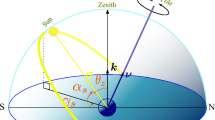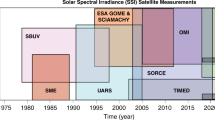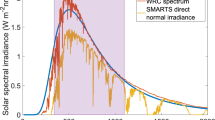Abstract
SCHEMES for the conversion of sunlight to useful (electrical, mechanical, chemical) energy all make use of the high spectral temperature of solar radiation relative to the terrestrial ambiance. Some schemes, but not others, also make use of the high directivity of the solar flux. For example, focusing mirror arrays require direct sunlight, while photovoltaic devices are indifferent to the directness or diffuseness of light of a given intensity. In biological systems, photosynthesis evidently makes little use of sunlight directivity, since it is not observed to depend strongly on plant orientation on angular scales as small as half a degree (the size of the Sun); on the other hand, Kevan1 reports some heliotropic, arctic flowers whose corollas are nearly paraboloidal and focus direct (but not diffuse) radiation on the sporophylls.
This is a preview of subscription content, access via your institution
Access options
Subscribe to this journal
Receive 51 print issues and online access
$199.00 per year
only $3.90 per issue
Buy this article
- Purchase on Springer Link
- Instant access to full article PDF
Prices may be subject to local taxes which are calculated during checkout
Similar content being viewed by others
References
Kevan, P. G., Science, 189, 723 (1975).
Spanner, D. C., Introduction to Thermodynamics 225 (Academic, New York, 1964).
Landsberg, P. T., in Electricité Solaire: proc. Int. Conf. Toulouse, 1–5 March, 1976 (in the press).
Landau, L. D., and Lifschitz, E. M., Statistical Physics, Section 19 (Pergamon, London, 1958).
Planck, M., The Theory of Heat Radiation, Section 157 (Dover, New York, 1959).
Oxenius, J., J. quant. Spectros. Radiat. Transfer, 6, 65 (1966).
Monteith, J. L., Principles of Environmental Physics, Chapter 3 (Americal Elsevier, New York, 1973).
Author information
Authors and Affiliations
Rights and permissions
About this article
Cite this article
PRESS, W. Theoretical maximum for energy from direct and diffuse sunlight. Nature 264, 734–735 (1976). https://doi.org/10.1038/264734a0
Received:
Accepted:
Issue Date:
DOI: https://doi.org/10.1038/264734a0
This article is cited by
-
Realistic maximum efficiency of solar energy conversion into work vs exergy efficiency
Energy Efficiency (2023)
-
A fully planar solar pumped laser based on a luminescent solar collector
Communications Physics (2020)
-
Human vision is determined based on information theory
Scientific Reports (2016)
-
Thermodynamic analysis on medium-high temperature solar thermal systems with selective coatings
Science China Technological Sciences (2013)
-
Nonequilibrium thermodynamics and maximum entropy production in the Earth system
Naturwissenschaften (2009)
Comments
By submitting a comment you agree to abide by our Terms and Community Guidelines. If you find something abusive or that does not comply with our terms or guidelines please flag it as inappropriate.



